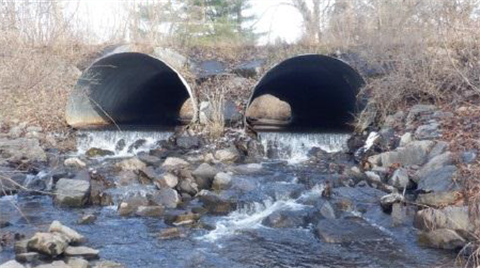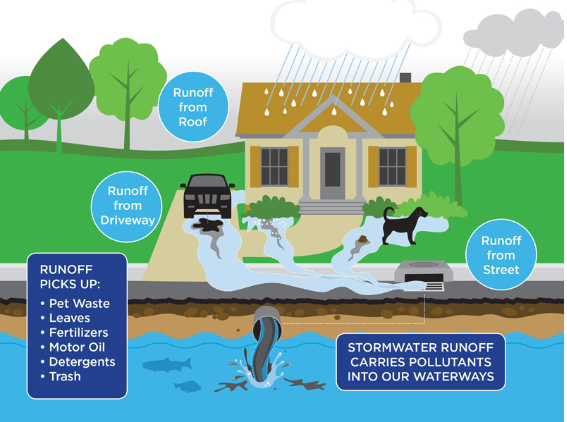Stormwater Management

Tompkins County is regulated under the New York State Department of Environmental Conservation SPDES General permit for Stormwater Discharges from Municipal Separate Storm Sewer Systems (MS4) program. MS4s are regulated by GP-0-24-001 and are required to meet requirements under six minimum controls measures and prepare a stormwater management plan and program to meet the requirements and benchmarks of this permit.
Our Permit ID is NYR20A278 and the County is a Traditional Non-Land Use Operator (ID: NYR20A278) and we discharge into the Cayuga Inlet, Fall Creek, Six-Mile Creek & the Southern end of Cayuga Lake.
New York State Department of Environmental Conservation (NYSDEC) defines:
Stormwater as water from rain or melting snow that doesn't soak into the ground but runs off into waterways. It flows from rooftops, over paved areas and bare soil, and through sloped lawns while picking up a variety of materials on its way. The quality of runoff is affected by a variety of factors and depends on the season, local meteorology, geography, and land use.
What's the Problem
As it flows, stormwater runoff collects and transports pollutants to surface waters. Although the amount of pollutants from a single residential, commercial, industrial, or construction site may seem unimportant, the combined concentrations of contaminants threaten our lakes, rivers, wetlands, and other waterbodies.
Pollution conveyed by stormwater degrades the quality of drinking water, damages fisheries and habitat of plants and animals that depend on clean water for survival. Pollutants carried by stormwater can also affect recreational uses of waterbodies by making them unsafe for wading, swimming, boating and fishing.
According to an inventory conducted by the United States Environmental Protection Agency (USEPA), half of the impaired waterways are affected by urban/suburban and construction sources of stormwater runoff.
Examples of Pollution in Stormwater:
-
Nutrients such as phosphorus and nitrogen can promote the overgrowth of algae, deplete oxygen in the waterway, and be harmful to other aquatic life.
-
Bacteria from animal wastes and illicit connections to stormwater systems can make nearby lakes and bays unsafe for wading, swimming, and the propagation of edible shellfish.
-
Oil and grease from spills during vehicle maintenance activities causes sheen and odor and makes transfer of oxygen difficult for aquatic organisms.
-
Sediment from construction activities clouds waterways and interferes with the habitat of living things that depend upon those waters.
-
Careless application of pesticides, herbicides, and fertilizers affect the health of living organisms and cause ecosystem imbalances.
-
Trash and debris damages aquatic life, introduces chemical pollution, and diminishes the beauty of our waterways.

What can be done?
Significant improvements have been achieved in controlling pollutants that are discharged from sewage and wastewater treatment plants. Across the nation, attention is being shifted to non-point source pollution, such as polluted stormwater runoff, that are not normally treated by wastewater treatment plants. Stormwater management, especially in urban areas, is becoming a necessary step in seeking further reductions in pollution in our waterways.
The best way to control stormwater pollution is at the source, where the contaminants can be identified, reduced, or contained before being conveyed to surface water. More often than not, it's more expensive and difficult to remove the combination of pollutants that are present at the end-of-pipe where stormwater is discharged directly to a receiving waterbody. Sometimes, significant improvements can be made by employing best management practices (BMPs). Proper storage of chemicals, good housekeeping, and just plain paying attention to what's happening during runoff events can lead to relatively inexpensive ways of preventing pollutants from getting into the runoff and our waterways.
 +
+ 
+ 
Tompkins County Highway, Environmental Health (A Division of Whole Health), and the Soil and Water Conservation District work together to help protect water quality throughout the County. The Highway department is the MS4 Operator, Environmental Health oversees the Onsite Wastewater Treatment (Septic) Systems and Illicit Discharge Complaints, and the Soil and Water Conservation District provides guidance, water quality improvement projects and educational resources throughout the County.

Tompkins County is a member of the Stormwater Coalition of Tompkins County. The Coalition was formed in 2003 and is an inter-municipal organization formed to assist municipal separate storm systems (MS4s) in cooperation, communication, and compliance with state regulations for stormwater discharges.
The Coalition consists of 10 municipalities within Tompkins County. The municipalities include Towns of Caroline, Danby, Dryden, Lansing, Newfield and Ulysses, the City of Ithaca, the Villages of Cayuga Heights and Lansing, and Tompkins County.
The coalition’s website is a great resource and has a variety of steps you can take to help keep stormwater from damaging the local landscape. https://tcstormwater.org/
Tompkins County's updated SWMP is available at the Highway Department Office during working hours at 170 Bostwick Road - Ithaca, NY 14850.
Please contact us at: stormwater@tompkins-co.org , if you have any questions.